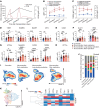Inhibiting the NADase CD38 improves cytomegalovirus-specific CD8+ T cell functionality and metabolism
- PMID: 38954588
- PMCID: PMC11364383
- DOI: 10.1172/JCI179561
Inhibiting the NADase CD38 improves cytomegalovirus-specific CD8+ T cell functionality and metabolism
Abstract
Cytomegalovirus (CMV) is one of the most common and relevant opportunistic pathogens in people who are immunocompromised, such as kidney transplant recipients (KTRs). The exact mechanisms underlying the disability of cytotoxic T cells to provide sufficient protection against CMV in people who are immunosuppressed have not been identified yet. Here, we performed in-depth metabolic profiling of CMV-specific CD8+ T cells in patients who are immunocompromised and show the development of metabolic dysregulation at the transcriptional, protein, and functional level of CMV-specific CD8+ T cells in KTRs with noncontrolled CMV infection. These dysregulations comprise impaired glycolysis and increased mitochondrial stress, which is associated with an intensified expression of the nicotinamide adenine dinucleotide nucleotidase (NADase) CD38. Inhibiting NADase activity of CD38 reinvigorated the metabolism and improved cytokine production of CMV-specific CD8+ T cells. These findings were corroborated in a mouse model of CMV infection under conditions of immunosuppression. Thus, dysregulated metabolic states of CD8+ T cells could be targeted by inhibiting CD38 to reverse hyporesponsiveness in individuals who fail to control chronic viral infection.
Keywords: Glucose metabolism; Immunology; T cells; Transplantation.
Conflict of interest statement
Figures








References
MeSH terms
Substances
LinkOut - more resources
Full Text Sources
Medical
Research Materials

